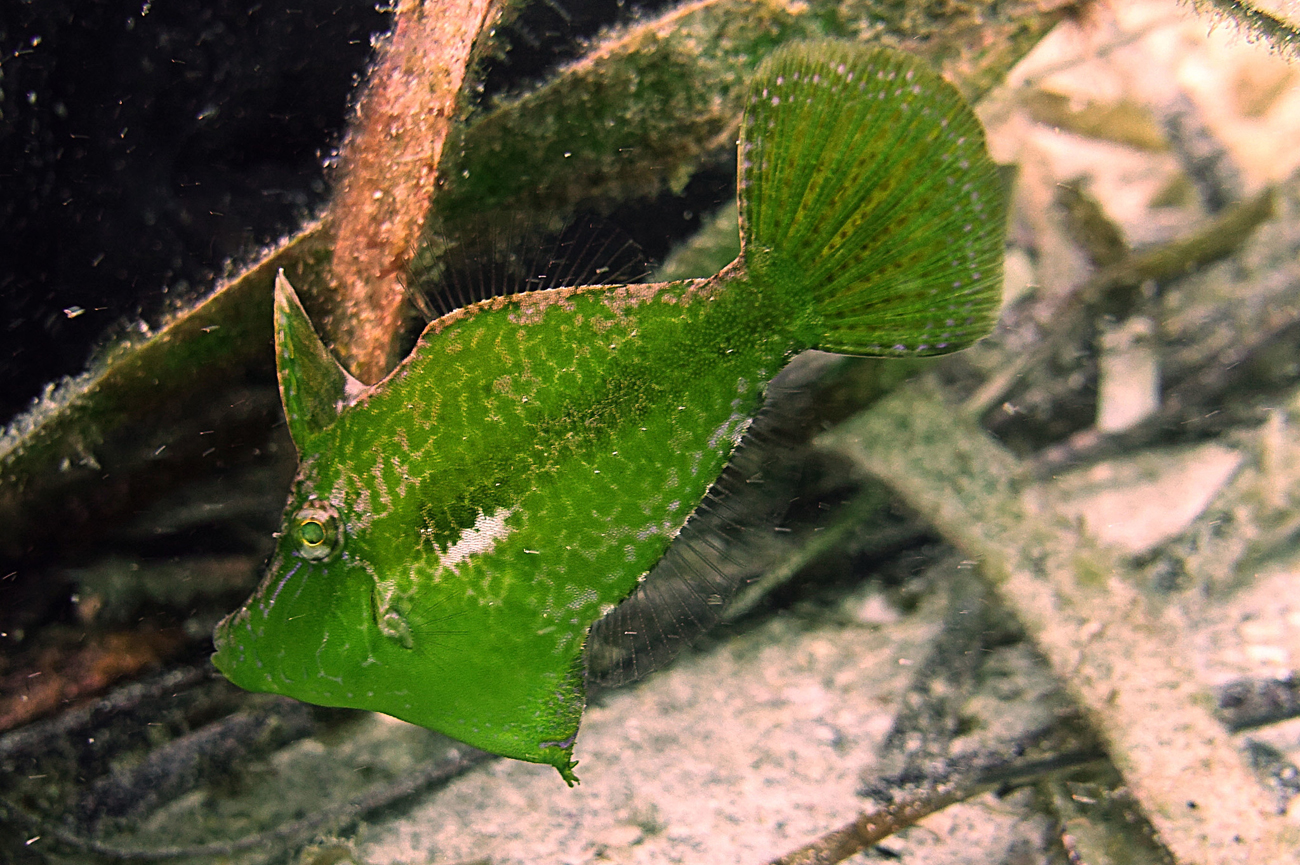Paxman's Leatherjacket, Colurodontis paxmani Hutchins 1977

Paxman's Leatherjacket, Colurodontis paxmani, at Coogee, Perth, Western Australia, May 2017. Source: Glen Whisson / iNaturalist.org. License: CC by Attribution-NonCommercial
Summary:
A pale greyish to pale blue or greenish to greenish-brownish leatherjacket with close-packed green and dark brown blotches, sometimes three broad indistinct stripes along the sides, two narrow iridescent blue lines on the snout, and three irregular dark brown blotches at the bases of the dorsal and anal fins.
Cite this page as:
Bray, D.J. 2018, Colurodontis paxmani in Fishes of Australia, accessed 30 Jun 2025, https://fishesofaustralia.net.au/Home/species/4190
Paxman's Leatherjacket, Colurodontis paxmani Hutchins 1977
More Info
|
Distribution |
Cockburn Sound in the south, to about Beagle Bay near Broome, Western Australia, also pelagic juveniles collected off Raine Island, Queensland. A small juvenile was also collected NW of the Dampier Archipelago in 100m. Pelagic juveniles have been found amongst floating Sargassum., while adults occur near seagrass and macroalgal beds. |
|
Features |
Dorsal fin 11 + 27-32; Anal fin 26-31; Pectoral fin 10-12; Caudal fin 12; Vertebrae 19. All external teeth with truncate cutting edges, anteriormost pair in each jaw extending across full width of mouth; two vertical small tusk-like processes on internal surface of anteriormost pair of teeth in lower jaw. First dorsal-fin spine originating over posterior half of eye, armed with 2 series of prominent downward-directed barbs on anterior face, much smaller and more numerous than those in postero-lateral rows. Scales on body with 1 central spinule supported by a transverse ridge, those spinules on caudal peduncle of adult male moderately elongate, curving anteriorly. Pelvic bony structure movably articulated with pelvis. |
|
Colour |
A pale grey to pale blue or greenish-brownish leatherjacket with close-packed green and dark brown blotches, the latter forming three indistinct stripes on sides; head greenish brown with 2 narrow iridescent blue lines on snout, extending from eye towards mouth, bending downwards to throat, posterior line forming a wavy pattern on side of throat which may extend onto side of breast; small iridescent blue spots may be present near upper profile of head and body; pale orange brown blotch on mid-side of caudal peduncle; first dorsal spine turquoise with dusky membrane; soft dorsal and anal fins hyaline to dusky with 3 irregular dark brown blotches on basal sheath, extending onto fins; caudal fin rays turquoise, membranes orange with a longitudinal row of brown spots between each ray, rays and membranes becoming blackish posteriorly (membrane between upper 2 and lower 2 rays entirely blackish); spinules on scales turquoise. The following are significant variations in live colour pattern : replacement of longitudinal body stripes with irregularly arranged greenish brown blotches; a pale blue stripe on dorsal profile, extending from snout tip to caudal peduncle; dark brown spots may be scattered on body, especially lower half, or absent. (Hutchins 1977) |
|
Etymology |
Colurodontis is from the Latin color meaning 'colour', and the Greek, odous meaning 'teeth'. The species is named paxmani B. Paxman who was instrumental in obtaining many monacanthid specimens for Dr Barry Hutchins. |
|
Author |
Bray, D.J. 2018 |
|
Resources |
Paxman's Leatherjacket, Colurodontis paxmani Hutchins 1977
References
Allen, G.R. 1997. Marine Fishes of Tropical Australia and South-east Asia. Perth : Western Australian Museum 292 pp. 106 pls.
Allen, G.R. & Swainston, R. 1988. The Marine Fishes of North-Western Australia. A field guide for anglers and divers. Perth, WA : Western Australian Museum vi 201 pp., 70 pls.
Hutchins, B. 2004. Fishes of the Dampier Archipelago, Western Australia. Records of the Western Australian Museum, Supplement 66: 343–398.
Hutchins, J.B. 1977. Descriptions of three new genera and eight new species of monacanthid fishes from Australia. Records of the Western Australian Museum 5(1): 3-58 figs 1-13 PDF
Hutchins, J.B. 1990. Fish survey of South Passage, Shark Bay, Western Australia. pp. 263-278 in Berry, P.F., Bradshaw, S.D. & Wilson, B.R. (eds). Research in Shark Bay: Report of the France-Australe Bicentenary Expedition Committee. Perth : Western Australian Museum.
Hutchins, J.B. 1997. Checklist of fishes of the Houtman Abrolhos Islands, Western Australia. pp. 239-253 in Wells, F. (ed.). The Marine Fauna and Flora of the Houtman Abrolhos Islands, Western Australia. Perth : Western Australian Museum.
Hutchins, J.B. 2001. Monacanthidae. pp. 3929-3947 in Carpenter, K.E. & Niem, T.H. (eds). The Living Marine Resources of the Western Central Pacific. FAO Species Identification Guide for Fisheries Purposes. Rome : FAO Vol. 6 pp. 3381-4218.





